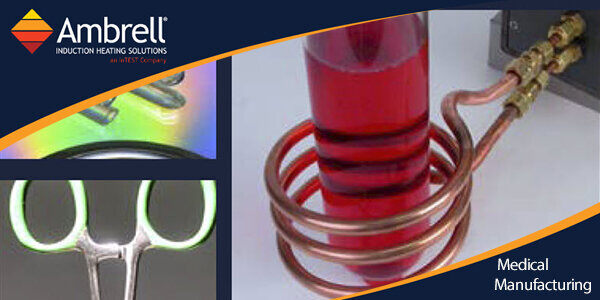Curing Material on an Aluminum Mandrel
Objective Heat a customer supplied aluminum cylinder to 80-120°C for a material curing application. More application notes
Processes
Processes: More
Processes: More

Industries:
Industries: More
Industries: More
Industries: More

Products:
Products: More
Services:
Services: More

Learn:
Learn: More
About:

2 min read
Brett Daly
7/24/23 11:35 AM

Induction heating is commonly used in medical manufacturing for a variety of applications. In this blog post, we'll review some of the most typical applications for induction in medical manufacturing:
Annealing: Annealing softens metal and improves its ductility. Induction heating is a highly effective way to anneal metal, as it can be done rapidly and precisely. In medical device manufacturing, this ensures the metal is annealed correctly and will not fail under stress.
Brazing: Brazing is a joining process that uses a molten filler metal to join two pieces of metal together. This happens to be one of our most popular induction applications. Induction heating is a very effective way to braze metal, as it quickly heats the filler metal to its melting point. A strong and durable brazed joint is commonly achieved with induction heating.
Soldering: Soldering is a joining process that uses a molten solder to join two pieces of metal together, but at a lower temperature than brazing. Induction is a very effective way to solder metal, as it can quickly heat the solder to its melting point. The end result is a strong and durable solder joint.
Hardening: Hardening increases the strength and hardness of metal. Induction heating is a highly effective way to harden metal, as it can heat the metal rapidly to the target temperature, after which point the metal is quenched to harden it. This results in a strong metal for end products that require it.
Heat treating: This term encompasses a number of heat treatment processes that are used to change the properties of metal. Induction heating is a common way to heat treat metal, as it can quickly and precisely heat the metal to the desired temperature.
In addition to the aforementioned applications, induction heating has other applications in medical manufacturing, including:
Cleaning: Induction heating can be used to clean metal parts by heating them to a target temperature and then quenching them to remove the contaminants from the metal and leave it clean and free of oxidation.
Forming: Induction can be used to form metal parts by heating them to a high temperature and then shaping them. This process is often used to make medical products that require precise shapes.
Testing: Induction heating can be used to test the properties of metal parts by heating them to a specific temperature and then measuring their properties. This is a valuable tool for ensuring that medical devices meet the required quality standards.
In summary, induction heating is versatile and effective for a wide variety of applications in medical manufacturing. It is a clean, precise, and efficient way to heat metal, and it can be used for a number of applications, from annealing and brazing to cleaning and forming. This makes it an optimal choice for manufacturers of medical devices, as quality and repeatability are particularly critical in the medical segment.
Our applications engineers have worked on countless medical manufacturing applications involving induction heating. Click on the image below to check out some of their medical device manufacturing application notes.

Objective Heat a customer supplied aluminum cylinder to 80-120°C for a material curing application. More application notes

In today’s manufacturing landscape, efficiency, precision, and sustainability are critical. Induction heating—a process that uses electromagnetic...

When it comes to many manufacturing processes, including this forging application, precision and efficiency are critical. Traditional heating methods...